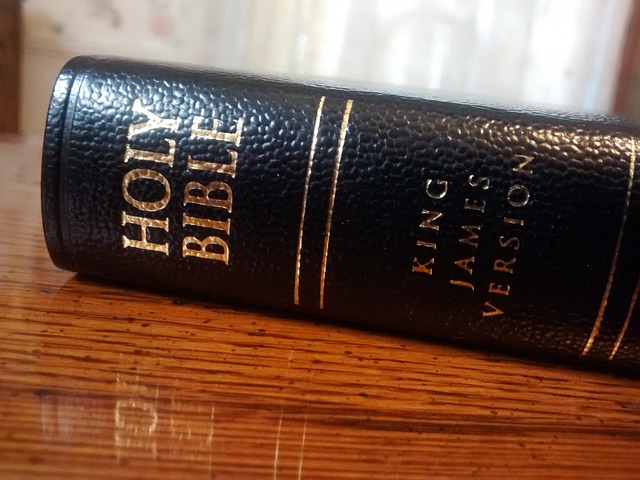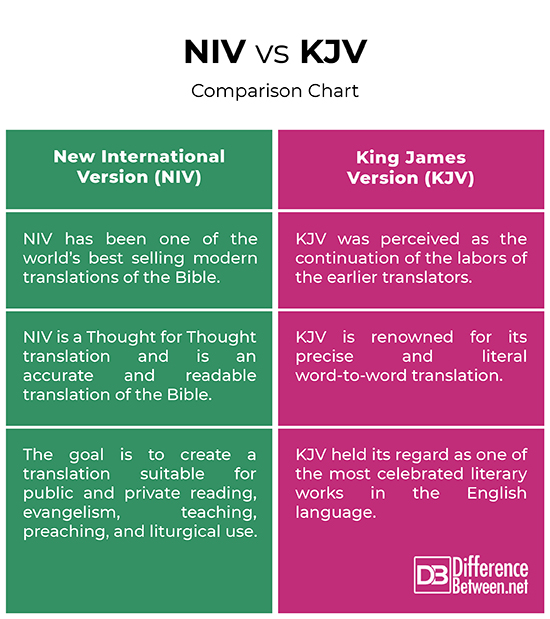Difference Between NIV and KJV
The Bible has been a vital source of unity among the Christians since ages. At the same time, it has been an important instrument of separation, maintaining boundaries between truth and falsehood, and separating the believers from the non-believers. In the modern times, the Bible has been translated into many versions in the English language, each unique in a number of ways. Two such popular English translations of the Bible are the New International Version (NIV) and the King James Version (KJV).

What is New International Version (NIV)?
The New International Version (NIV) is considered to be the most popular and widely read modern English translation of the Bible first printed in 1978 by the former International Bible Society. The NIV is believed to be an accurate and readable translation of the Word of God in contemporary English. Translated by a team of world-class scholars and leaders in their respective fields, the NIV is accurate, readable, and clear, yet true to the original Hebrew, Aramaic, and Greek of the Bible. The NIV is a great translation for the first time Bible readers looking to discover the God’s word. The NIV underwent a minor revision in 1984 and later updated in 2011. Since then, the NIV has been one of the world’s best selling modern translations of the Bible.

What is King James Version (KJV)?
The King James Version (KJV) is the world’s most popular historic translation of the Bible that has edified millions of English-speaking Christians around the world. Also known as the King James Bible (KJB) and the Authorized Version, the KJV is regarded as the most accurate translation of the Bible and known for its literal word-to-word translation. It was the first ‘people’s Bible’ and definitely held its regard as one of the most celebrated literary works in the English language. The King James Version was commissioned in 1604 and the Bible was finally published seven years later in 1611. It’s believed that the King James Version was translated from the traditional Hebrew text and also the New Testament being translated from the Textus Receptus – the name of the first published Greek text of the New Testament.
Difference between NIV and KJV
Origin
– The NIV began when a businessman was trying to share his faith with a friend and he was reading to him out of the King James Bible. His friend said “am I supposed to understand that.” This single incident sparked the NIV as the Biblica (formerly International Bible Scoiety) took the project and started working on it with the help of a team of 15 scholars from all over the country. The full Bible was finally released in 1978. The NIV was then updated in 1984 and 2011.
In 1604, King James called for a meeting at the Hampton Court Palace to address the concerns regarding the earlier translations perceived by the Puritans. The King initially disregarded most of their requests. The lead Puritan voice proposed the idea of a Bible translation. King James, who hated the popular Geneva Bible for its anti-royalty message, agreed with the idea of a new translation. The new translation was finally completed in 1610 and published in 1611.
Readability
– The core desire of the NIV is to be understandable in broad international English and the idea was to create a translation that would sound just right to the people who live now. The NIV is accurate, readable, and clear, yet true to the original Hebrew, Aramaic, and Greek of the Bible. The KJV was the Authorized Version being translated via the Antioch manuscript textline, and also the New Testament being translated from the Textus Receptus.
Accuracy
– The NIV is believed to be an accurate and readable translation of the Word of God in contemporary English, translated by a team of world-class scholars and leaders in their respective fields. The NIV is a Thought for Thought translation. The KJV is also viewed as an exemplary English translation of the Bible which is still considered one of the most accurate versions around when comes to the underlying text and its literal word-to-word translation.
NIV vs. KJV: Comparison Chart

Summary
It is clear that both of them are the very popular modern English translations of the Bible; one of them is read widely and another one is a best seller. For nearly four centuries, and throughout several revisions of its English form, the KJV has been deeply revered among the English-speaking people of the world. The translators of the KJV were committed to producing a precise translation of the Bible without practicing any paraphrasing. But, NIV is the widely read modern translation of the Word of God in contemporary English and is true to the original Hebrew, Aramaic, and Greek of the Bible.
What verses are missing from the NIV Bible?
There are 16 verses that are completely left out from the NIV.
Is the NIV a good version of the Bible?
The NIV was a great translation suitable for public and private reading, evangelism, teaching, preaching, and liturgical use. It is the widely read translations of the Bible in contemporary English.
Is the KJV the most accurate translation?
The KJV translators were committed to producing a precise and accurate translation of the English Bible, which by no means, should be a paraphrase or an approximate rendering. But many people believe KJV is not the most accurate translation of the Bible, since there are tons of other translations around.
What is the most accurate translation of the Bible in the world?
The New American Standard Bible (NASB) is certainly well regarded as one of the most literally translated English Bibles of the 20th century.
Which version of the Bible is closest to the original text?
The NASB is a literal word-to-word translation from the original texts, which is still considered as the most accurate. Besides the NASB, the KJV, the English Standard Version (ESV), and the New English Translation (NET) are other few examples of word-to-word translation.
Which Bible translation is the easiest to read?
Many people believe that the New Living Translation (NLT), which relies on the critical editions of the original Hebrew and Greek texts, is the easiest Bible translation to read because it uses modern English.
- Difference Between Caucus and Primary - June 18, 2024
- Difference Between PPO and POS - May 30, 2024
- Difference Between RFID and NFC - May 28, 2024
Search DifferenceBetween.net :
4 Comments
Leave a Response
References :
[0]The Complete Evangelical Parallel Bible: King James Version / New King James Version / New International Version / New Living Translation. Massachusetts, United States: Hendrickson Publishers, 2013. Print
[1]The Books of the Bible, NIV. Michigan, United States: Zondervan, 2012. Print
[2]Brunn, Dave. One Bible, Many Versions: Are All Translations Created Equal?. Illinois, United States: InterVarsity Press, 2013. Print
[3]Image credit: https://pixabay.com/photos/bible-kjv-holy-bible-brown-bible-998150/
[4]Image credit: https://commons.wikimedia.org/wiki/File:Bible_and_hymnal.jpg

I grew up from the 60s that the Hebrew,Latin,and Greek were the Bible of Gods true words and the people’s words in the bible, KJV 1611 is The Offspring of God and the peoples true words, before people started changing,Removing and Replacing Father and the peoples original words.
I read the ESV, King James which the English is old school England. I love the NIV. Easy reading and language I understand. I also read the New King James which uses a few different words to describe situations. I have been a baptized Christian for 51 years and was raised old time baptism. So I would recommend the ESV and NIV.
It is stated that the ASB and KJV are translated from the original texts… Sorry, but they are copies of copies of translations of copies… No originals exist… I submit its all made up fantasy fictiion… JMHO
The Holy Spirit will lead you into all truth .. when received speaking in tongues as it is written in acts C 2 v V 37……. The word of God will open your eyes to his understanding.. there is parrabels that anyone can understand but when you pray the word will open up and you will have a clear understanding .. there is so many bibles .. religious places.. it is so confusing .. the Lord knows whom are is his sheep because they will hear what is right because they will hear when they are called .. as it is written my sheep will hear my voice ….